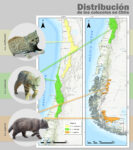Assessment of the current distribution of the colocolo cat, Leopardus colocola (Molina 1782) in Chile and its implications in the taxonomy of the species
Carlos Augusto Castro-Pastene, Rodrigo Antonio Villalobos Aguirre, Nicolás Lagos Silva, Cristian Fernando Sepúlveda Cabrera, Daniel Cross Ossa, Natalia Valenzuela-Aedo, Bernardo Tobías Segura Silva, Agustín Iriarte Walton, Felipe Andrés Hernández Muñoz, Mauricio Rodrigo Soto-GamboaThe three colocolo cat populations (Leopardus colocola) in Chile are associated with the Altiplano, the Mediterranean forest and the Patagonian steppes. They have traditionally been considered isolated and distant from each other, and have even been potentially viewed as different species by some authors. We used available information and the georeferenced data obtained from our own observations (through direct observations, images from trail cameras, indirect signs of the species, museum records, description of the areas in scientific literature and georeferencing applications). We created an updated distribution map for the entire country and compared it to historical distribution maps. We have contributed to over 207 unpublished records, defining for the first time the distribution of L. c. wolffsohni from the Region of Arica and Parinacota to the town of “El Chollay”. We also contributed to increase the distribution of L. c. colocola by more than 300 km to the north (near Paposo) and define its southern limit in the sector of Laguna del Laja. As for the subspecies L. c. pajeros, this would be associated with the Patagonian steppe ecosystem. The subspecies L. c. wolffsohni and L. c. colocola have a wider distribution than reported in the scientific literature and are probably even connected, since there are no natural boundaries separating them and their records are 46 km apart. The updated maps will support future taxonomic analyses and help detect the principal threats that endanger the species (such as mining activity and land-use change).
Evaluación de la distribución actual del gato colocolo Leopardus colocola (Molina 1782) en Chile y sus implicaciones en la taxonomía de la especie. Las tres poblaciones de gato colocolo (Leopardus colocola) en Chile están asociadas al altiplano, el bosque mediterráneo y las estepas patagónicas. Estas han sido tradicionalmente consideradas como aisladas y distantes una de otras, y han sido potencialmente vistas como diferentes especies por algunos autores. Usamos la información disponible y los datos georreferenciados de nuestras observaciones (a través de observaciones directas, imágenes de cámaras trampa, registros indirectos de la especie, registros de museos, áreas descritas en la literatura científica y aplicaciones de georreferencia), y hemos creado un mapa actualizado de la distribución para todo el país, que comparamos con los mapas de distribución histórica. Contribuimos con más de 207 registros no publicados para la primera distribución de L. c. wolffsohni, que iría desde las regiones de Arica y Parinacota a la localidad de «El Chollay». Incrementamos la distribución de L. c. colocola en más de 300 km al norte (cerca de Paposo) y definimos su límite sur en el sector de laguna del Laja. En cuanto a la distribución de L. c. pajeros, esta podría estar asociada con el ecosistema de la estepa patagónica. Las subespecies L. c. wolffsohni y L. c. colocola tienen una distribución más amplia que la informada por la literatura científica y probablemente estén conectadas debido a que no existen barreras naturales que las separen, y sus registros están separados por 46 km. La actualización de los mapas de distribución contribuirá para futuros análisis taxonómicos y ayudarán a evaluar las principales amenazas que enfrenta la especie (como actividad minera o cambio de uso de suelo).
